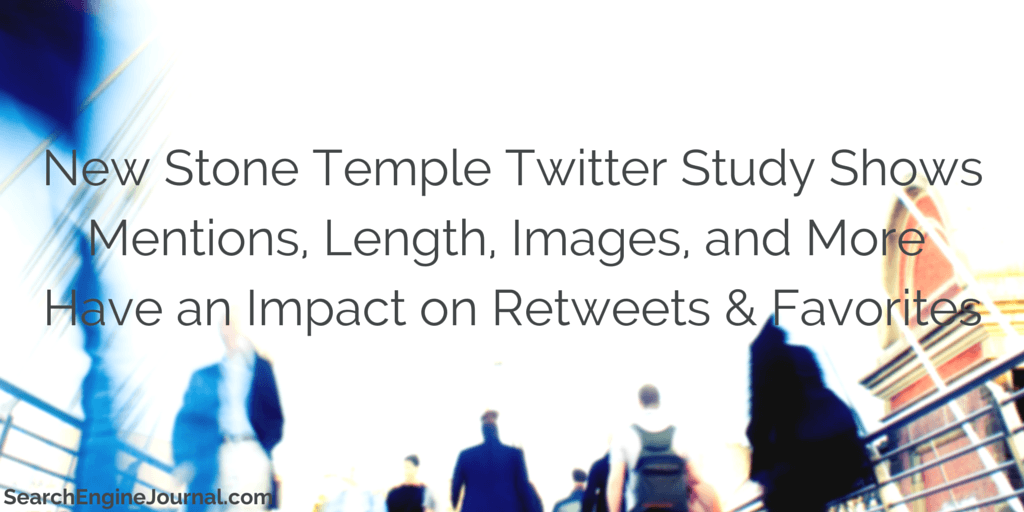
Eric Enge and his Stone Temple Consulting team have released on a new study on Twitter engagement today, specifically examining the effects of metrics like hashtag length, social authority, and images on the number of Favorites and Retweets. Eric gave me an exclusive interview on the study and how its insights are important to social media marketers.
1. It seems like you use the Twitter API to pull data. How can marketers utilize the API to pull data to make choices about their campaigns?
Great question, and not one I have spent much time thinking about, but here is an idea for you. Marketers can use the idea to do “social listening,” i.e., they can look monitor the Twitter Search API to see certain keywords (like their brand name) and tell them when someone is talking about them, and then they can use that to signal a need to respond, or simple monitor overall sentiment.
Alternatively, they can monitor other keywords to see what they want to respond to as well. This could be a more proactive data exercise oriented around discovering new business opportunities. Consider what Hilton Suggests does. They notice when people are looking for things near one of their hotels (e.g. a restaurant) and they proactively respond to help the perrson out. They will do this even if the person is currently staying at a competitive hotel. Pretty cool!
2. Social authority has a huge impact on the effectiveness and engagement of tweets. How does high and low authority affect a tweet’s success or failure in specific areas, like mentions?
Very high authority accounts (like Justin Bieber, who has a Followerwonk social authority of 100) that nearly anything they tweet gets tons of engagement. It’s so high, in fact, that there is no remaining upside. Whether or not they include images or not seems to make no difference. In some scenarios, they can even potentially get some down site as a result of the process.
For example, if you have a 90 to 100 social authority, and you include a mention, you can actually lower your engagement. Including links also seems to potentially lower the engagement. The price of fame, perhaps, but it’s hard to feel bad for people for whom engagement is so automatic!
3. The study also showed that image sharing has a huge impact on engagement. Can you elaborate on that?
Oh my. The impact of including an image has long been known to be a positive factor, but our study showed just how big a factor it it. Including a relevant image increased the average total retweets you can get by 5 to 9 times and the total number of favorites by 4 to 12 times.
It it is important to note that even though we used 1.94 million tweets, all in western languages only, that the actual level of gain you get can vary significantly. However, it is inescapably obvious at this point that the impact including images is huge. If you are looking to drive engagement with your Twitter campaigns, you’d be nuts to not include images with your tweets.
Of course, the relevance of the image, the quality of the image, and it’s ability to help trigger an emotional response in the viewing audience are all factors. Don’t simply throw any old image out there and expect to suddenly multiply your engagement. There is an art/science to doing it well, and it’s important to learn as much as you can about that and share truly compelling imagery.
4. Which aspect of a tweet (hashtag length, number of @ mentions, etc), do you think is most important?
Great examples Kelsey! It’s interesting in our data, because we saw little difference in engagement based on hashtag length. It just seemed to be a non-factor. However, including a mention was a negative factor (even when the mention was not at the very beginning of the tweet). It could be that the focused nature of the dialog cause other people to be less likely to respond.
5. Is there anything else the study didn’t include that you found interesting or important?
Definitely. One area we examined that proved to be a non-event was a check for the Domain Authority of a shared link. The theory was that sharing higher DA links might cause more reshares. Interestingly enough, it was just not compelling or interesting at all.
We also tested the impact of including more than one link. While we showed that including “more than zero” links had a small beneficial impact, the impact is actually larger when you share 3 links. Not sure why that it, but it was pretty interesting indeed!
Thanks to Eric and the Stone Temple team for this interview and such a useful study!
Images provided by Stone Temple Consulting.






